Technology Category
- Cybersecurity & Privacy - Cloud Security
- Networks & Connectivity - Gateways
Applicable Industries
- Electronics
- National Security & Defense
Applicable Functions
- Human Resources
- Maintenance
Use Cases
- Tamper Detection
- Time Sensitive Networking
Services
- Cloud Planning, Design & Implementation Services
- Training
About The Customer
Founded in 1974, Crutchfield Corporation is a leading catalogue and Internet retailer of consumer electronics. The organization has a diverse employee base, which includes call center staff, distribution agents, and traditional knowledge workers. The company is committed to protecting its corporate assets from web-based threats, which is critical to its business continuity. The company's IT infrastructure is managed by Paul Fitzsimmons, Senior Manager of IT Systems, who was looking for a comprehensive security solution to replace the company's ineffective legacy URL filtering solution.
The Challenge
Crutchfield Corporation, a leading catalogue and Internet retailer of consumer electronics, faced a significant challenge in protecting its corporate assets from web-based threats. The company's legacy URL filtering solution was ineffective, often allowing threats to go undetected as it was not deployed in-line with traffic. It was unable to protect against zero-day exploits despite frequent maintenance updates. Furthermore, the solution was not trivial to protect multiple Internet gateways and the growing base of mobile users. The company needed a comprehensive security solution that could effectively protect its diverse employee base, including call center staff, distribution agents, and traditional knowledge workers.
The Solution
Crutchfield Corporation turned to a web security Software as a Service (SaaS) solution to meet its requirements. The SaaS solution was easy to deploy and maintain, requiring no capital expenditure and minimal operational costs. However, the company faced challenges with the first three cloud security vendors it evaluated, as their solutions introduced unacceptable latencies and required administration of 'thick' clients, disrupting business and increasing costs. Following Gartner’s advice, Crutchfield evaluated the Zscaler service. Zscaler offered ultra-low latency, dynamic protection against advanced threats, lower cost due to easy deployment and maintenance, and real-time forensics of network activity.
Operational Impact
Quantitative Benefit

Case Study missing?
Start adding your own!
Register with your work email and create a new case study profile for your business.
Related Case Studies.

Case Study
Remote Temperature Monitoring of Perishable Goods Saves Money
RMONI was facing temperature monitoring challenges in a cold chain business. A cold chain must be established and maintained to ensure goods have been properly refrigerated during every step of the process, making temperature monitoring a critical business function. Manual registration practice can be very costly, labor intensive and prone to mistakes.

Case Study
Predictive maintenance in Schneider Electric
Schneider Electric Le Vaudreuil factory in France is recognized by the World Economic Forum as one of the world’s top nine most advanced “lighthouse” sites, applying Fourth Industrial Revolution technologies at large scale. It was experiencing machine-health and unplanned downtime issues on a critical machine within their manufacturing process. They were looking for a solution that could easily leverage existing machine data feeds, be used by machine operators without requiring complex setup or extensive training, and with a fast return on investment.

Case Study
Cloud Solution for Energy Management Platform-Schneider Electric
Schneider Electric required a cloud solution for its energy management platform to manage high computational operations, which were essential for catering to client requirements. As the business involves storage and analysis of huge amounts of data, the company also needed a convenient and scalable storage solution to facilitate operations efficiently.

Case Study
Leveraging the IoT to Gain a Competitive Edge in International Competition
Many large manufacturers in and outside Japan are competing for larger market share in the same space, expecting a growing demand for projectors in the areas of entertainment, which requires glamor and strong visual performance as well as digital signage that can attract people’s attention. “It is becoming more and more difficult to differentiate ourselves with stand-alone hardware products,” says Kazuyuki Kitagawa, Director of Service & Support at Panasonic AVC Networks. “In order for Panasonic to grow market share and overall business, it is essential for us to develop solutions that deliver significant added value.” Panasonic believes projection failure and quality deterioration should never happen. This is what and has driven them to make their projectors IoT-enabled. More specifically, Panasonic has developed a system that collects data from projectors, visualizes detailed operational statuses, and predicts issues and address them before failure occurs. Their projectors are embedded with a variety of sensors that measure power supply, voltage, video input/ output signals, intake/exhaust air temperatures, cooling fan operations, and light bulb operating time. These sensors have been used to make the projector more intelligent, automatically suspending operation when the temperature rises excessively, and automatically switching light bulbs. Although this was a great first step, Panasonic projectors were still not equipped with any capability to send the data over a network.









